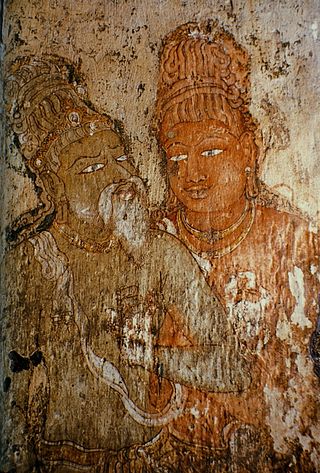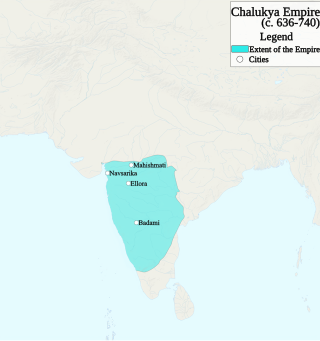
Rajaraja I, also known as Rajaraja the Great, was a Chola emperor who reigned from 985 CE to 1014 CE. He is known for his conquests of southern India and parts of Sri Lanka, and increasing Chola influence across the Indian Ocean. Rajaraja's birth name was Arulmozhi Varman.

Kulottunga Chola I also spelt Kulothunga, born Rajendra Chalukya, was a Chola Emperor who reigned from 1070 to 1122 succeeding his cousin Athirajendra Chola. He also served as the Eastern Chalukya monarch from 1061 to 1118, succeeding his father Rajaraja Narendra. He is related to the Chola dynasty through his mother's side and the Eastern Chalukyas through his father's side. His mother, Ammangaidevi, was a Chola princess and the daughter of emperor Rajendra Chola I. His father was king Rajaraja Narendra of the Eastern Chalukya dynasty who was the nephew of Rajendra and maternal grandson of Rajaraja Chola I. According to historian Sailendra Nath Sen, his accession marked the beginning of a new era and ushered in a period of internal peace and benevolent administration. He was succeeded by his son Vikrama Chola

Avani is a small village in Mulabaagilu taluk, Kolara district in Karnataka, India, about ten miles from Kolar Gold Fields. The village is located at 32 km from Kolara, the district centre and 13 km from Mulabaagilu, the Taluk headquarters. It is a popular location for rock climbing.

Western Ganga was an important ruling dynasty of ancient Karnataka in India which lasted from about 350 to 999 CE. They are known as "Western Gangas" to distinguish them from the Eastern Gangas who in later centuries ruled over Kalinga. The general belief is that the Western Gangas began their rule during a time when multiple native clans asserted their freedom due to the weakening of the Pallava empire in South India, a geo-political event sometimes attributed to the southern conquests of Samudra Gupta. The Western Ganga sovereignty lasted from about 350 to 550 CE, initially ruling from Kolar and later, moving their capital to Talakadu on the banks of the Kaveri River in modern Mysore district.

Vikramaditya VI became the Western Chalukya King after deposing his elder brother Someshvara II, a political move he made by gaining the support of Chalukya vassals during the Chola invasion of Chalukya territory. Vikramaditya's reign is marked with the abolishment of the Saka era and the start of the Chalukya-Vikrama era. He was the greatest of the Western Chalukya kings and had the longest reign in the dynasty. He earned the title Permadideva and Tribhuvanamalla. He had several queens who ably assisted him in administration. One of his queens, Chandala Devi, a princess from the Shilahara ruling family of Karad was called Abhinava Saraswati for her skills as an artist. Queen Kethala Devi administered the Siruguppa region and Savala Devi was in charge of an Agrahara in Naregal. According to the historian Kamath, Vikramaditya VI was a "great king who ruled over South India" and he finds a "pride of place in Karnataka history". More inscriptions in Kannada are attributed to Vikramaditya VI than any other king prior to the Vijayanagara era.

The Telugu Chodas or Telugu Cholas were rulers who ruled parts of present-day Andhra Pradesh, Telangana and southern Odissa as samantas (vassals) of the Pallavas, and later as vassals of the Imperial Cholas. There are many branches like Renati Chodas, Pottapi Chodas, Konidena Chodas, Nannuru Chodas, Nellore Chodas and Kunduru Chodas. The origins of the Telugu Chodas are diverse; while some claimed descent from Karikala, others were local Telugu-speaking feudatories of the Cholas in the Andhra region who added "Choda" to their names as an honorific.

Eastern Chalukyas, also known as the Chalukyas of Vengi, were a dynasty that ruled parts of South India between the 7th and 12th centuries. They started out as governors of the Chalukyas of Badami in the Deccan region. Subsequently, they became a sovereign power, and ruled the Vengi region of present-day Andhra Pradesh until c. 1001 CE. They continued ruling the region as feudatories of the Medieval Cholas until 1189 CE.

Tailapa II also known as Taila II and by his title Ahavamalla, was the founder of the Western Chalukya Empire in peninsular India. Tailapa claimed descent from the earlier imperial Chalukyas of Vatapi (Badami), and initially ruled as a Rashtrakuta vassal from the Tardavadi-1000 province in the present-day Vijayapura district of Karnataka. When the Rashtrakuta power declined following an invasion by the Paramara king Siyaka, Tailapa overthrew the Rashtrakuta emperor Karka II, and established a new dynasty.
Krishna II ascended the Rashtrakuta throne after the demise of his illustrious father Amoghavarsha I Nrupatunga. His Kannada name was Kannara. His queen was a Haihaya princess of Chedi called Mahadevi. From the chronology of inscriptions that mention the name of this emperor, it seems Krishna II may have started to rule even during the lifetime of his father. The fact that Amoghavarsha in his last years renounced the affairs of the state in dharmic pursuits supports this claim. The reign of emperor Krishna II saw significant advances in literature, although in the affairs of expansion of the empire, his reign was mixed. During his reign he cultivated matrimonial alliance with Chedis to form military gain.

Cholas of Nellore also known as Nellore Chodas or Nellore Cholas, were one of the branch of Telugu Chola families who ruled over parts of Andhra Pradesh in the 11th and 14th centuries. They were chieftains to Imperial Cholas, Kakatiyas and Western Chalukyas and ruled over the Nellore region. The dominance of Nellore Cholas grew towards the end of the Velanandu Chola dynasty, they claimed descent from the early Chola Tamil king Karikala Chola.
The Western Ganga Dynasty ruled large parts of southern Karnataka from the fourth century CE till the late tenth century CE with their regal capital initially at Kolar and later at Talakad in Mysore district, Karnataka. The origin of the Ganga clan prior to the fourth century is shrouded in legends and myths. Clarity into their history comes from such contemporaneous writings as Chavundaraya Purana in Kannada and Lokhavibhaga in Prakrit and from numerous inscriptions excavated in the Mysore, Bangalore and Kolar districts and Anantapur district. The Western Gangas played a pivotal role in the development of polity, culture and literature during their long rule in the region, at times as independent monarchs and at other times as subordinates of their larger neighbors: the Badami Chalukyas and later the Rashtrakutas of Manyakheta. Their patronage to literature in Kannada and Sanskrit, their achievements in architecture including the famous monolith of Gomateshwara, their Hindu temples in the southern Karnataka, and their Jain Basadi's of Shravanabelagola and Kambadahalli are testimony to the rich contribution they made to the region.
The Western Ganga Dynasty was an important ruling dynasty of ancient Karnataka. Its members are known as Western Gangas to distinguish them from the Eastern Gangas who in later centuries ruled over modern Orissa. The Western Gangas ruled as a sovereign power from the middle of fourth century to middle of sixth century, initially from Kolar, later moving their capital to Talakad on the banks of the Kaveri River in modern Mysore district. Though territorially a small kingdom, the Western Ganga contribution to polity, culture and literature of the modern south Karnataka region is considered noteworthy. The Ganga kings showed benevolent tolerance to all faiths but are most famous for their patronage towards Jainism resulting in the construction of fine monuments in such places as Shravanabelagola and Kambadahalli.
The Nolamba dynasty the area they held sway over is referred to as Nolambasa-37 of Henjeru (Hemavathi), Nolambalige (Nolambavadi-32000), etc. R. Narasimhacharya states that the Nolambas were a native Kannada dynasty. An inscription says that the Nolamba dynasty claimed descent from the King Trinayana Pallava.

Rajaditya Chola was a Chola prince, son of king Parantaka I and a Chera princess, known for commanding the Chola troops in the battle of Takkolam (948–949).

The Chalukya dynasty was a Classical Indian dynasty that ruled large parts of southern and central India between the 6th and the 12th centuries. During this period, they ruled as three related yet individual dynasties. The earliest dynasty, known as the "Badami Chalukyas", ruled from Vatapi from the middle of the 6th century. The Badami Chalukyas began to assert their independence at the decline of the Kadamba kingdom of Banavasi and rapidly rose to prominence during the reign of Pulakeshin II. After the death of Pulakeshin II, the Eastern Chalukyas became an independent kingdom in the eastern Deccan. They ruled from Vengi until about the 11th century. In the western Deccan, the rise of the Rashtrakutas in the middle of the 8th century eclipsed the Chalukyas of Badami before being revived by their descendants, the Western Chalukyas, in the late 10th century. These Western Chalukyas ruled from Kalyani until the end of the 12th century.
Perumbanappadi was the original home of the historic Bana Chieftains of the early Pallava period. It extended from the South Pennar to the Tirupati (Thirumala) hills. Perumbanappadi was made up of sub-divisions such as the Thiruvenkata-Kottam, and many Nadus such as Tuy-nadu, Puli-nadu, Vada Pulinadu, and Silai-nadu within it. During the Chola period, Perumbanappadi was a major division of the Jayakonda Chola Mandalam. and also represented the north-western portions of Thondai-Mandalam.
Kundhavai was a historic and a popular name of a number of royal women in southern India between the ninth and eleventh century. Some of the women who went by the name Kundavai are as follows:
The Battle of Takkolam (948–949) was a military engagement between a contingent of troops led by Rajaditya, crown prince and eldest son of the Chola king Parantaka I (907–955), and another led by the Rashtrakuta king Krishna III (939–967) at Takkolam in southern India. The battle resulted in the death of Rajaditya on the battlefield and the defeat of the Chola garrison at Takkolam.
The Battle of Vijayawada was fought in 1068 between the Chola army under Virarajendra Chola and the Western Chalukya army commanded by Vikramaditya VI near the present-day city of Vijayawada in Andhra Pradesh, India. The war resulted in the recovery of Vengi Andhra by the Cholas and coronation of Vijayaditya VII as Eastern Chalukya ruler by Virarajendra Chola.

The Nidugal Cholas were a dynasty of chiefs who ruled parts of Karnataka during the 8th and 13th centuries. Their stronghold was the hill fortress of Nidugal. The most famous among the line was Irungola deva Chola Maharaja who had his capital at Henjeru. They were hostile towards the Hoysalas and resisted them, but were subdued for a brief time during the reign of Vishnuvardhana. Later, they once again asserted their independence with the decline of the Chola and Hoysala kingdoms. They bore titles such as Lord of Uraiyur and claimed descent from the Sangam age king Karikala Chola.











